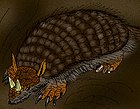Trachycalyptus: Difference between revisions
mNo edit summary |
|||
| (8 intermediate revisions by 5 users not shown) | |||
| Line 1: | Line 1: | ||
{{Short description|An extinct genus of mammals belonging to the armadillo order of xenarthrans}} |
{{Short description|An extinct genus of mammals belonging to the armadillo order of xenarthrans}} |
||
{{About|an extinct genus of Armadillos|the plant genus|Trachycarpus}} |
|||
{{No footnotes|date=June 2022}} |
{{No footnotes|date=June 2022}} |
||
{{Automatic taxobox |
{{Automatic taxobox |
||
| fossil_range = [[ |
| fossil_range = [[Pliocene|Early Pliocene]] <br />~{{fossil range|5|4}} |
||
| image = |
| image = |
||
| image_caption = |
| image_caption = |
||
| Line 14: | Line 15: | ||
* ''T. cingulatus'' {{small|Ameghino, 1889}} |
* ''T. cingulatus'' {{small|Ameghino, 1889}} |
||
}} |
}} |
||
'''''Trachycalyptus''''' is an [[extinct]] [[genus]] of [[glyptodont]]. It lived during the Early [[Pliocene]], and its fossilized remains were discovered in [[South America]]. |
'''''Trachycalyptus''''' is an [[extinct]] [[genus]] of [[glyptodont]]. It lived during the Early [[Pliocene]], and its fossilized remains were discovered in [[South America]]. |
||
==Description== |
==Description== |
||
Like all glyptodonts, ''Trachycalyptus'' had |
Like all glyptodonts, ''Trachycalyptus'' had a heavy body protected by a sturdy armor composed of osteoderms fused together. It had wrinkled and strongly punctuated osteoderms ; the central figure was mainly distinguished by a lower density of small holes on its surface. The absence of radial groove allows to distinguish it from other genera of glyptodonts. The tail was protected by a caudal tube, characterized by the presence of wrinkled osteoderms with numerous vascular perforations, without differentiation of the peripheral area. There were three pairs of large lateral osteoderms on the tail. |
||
==Classification== |
==Classification== |
||
The genus ''Trachycalyptus'' was first described in 1908 by [[Florentino Ameghino]], based on fossil remains found in Pliocene terrains of [[Argentina]]. The type species is ''Trachycalyptus chapadmalensis''. A Late Miocene species, ''Trachycalyptus cingulatus'', initially ascribed by [[Florentino Ameghino]] to another genus, was later tentatively attributed to this genus, although this attribution is still contested. It was similar to ''[[Trachycalyptoides]], from the Late Miocene of [[Bolivia]]. |
The genus ''Trachycalyptus'' was first described in 1908 by [[Florentino Ameghino]], based on fossil remains found in Pliocene terrains of [[Argentina]]. The type species is ''Trachycalyptus chapadmalensis''. A Late Miocene species, ''Trachycalyptus cingulatus'', initially ascribed by [[Florentino Ameghino]] to another genus, was later tentatively attributed to this genus, although this attribution is still contested. It was similar to ''[[Trachycalyptoides]]'', from the Late Miocene of [[Bolivia]]. |
||
''Trachycalyptus'' was a member of the |
''Trachycalyptus'' was a member of the glyptodont [[Sclerocalyptini]] ; it was originally considered closely related to the genus ''[[Urotherium]]''; however, it was recently placed closer to the genera ''[[Lomaphorus]]'' and ''[[Neosclerocalyptus]]''. |
||
==Bibliography== |
==Bibliography== |
||
*Cruz, L. E. and Fernicola, J. C. 2010. Las especies del género Trachycalyptus Ameghino (Glyptodontia): consideraciones taxonómicas. Jornadas Argentinas de Paleontología de Vertebrados; 2010. |
|||
{{Cingulata Genera|C.|state=autocollapse}} |
{{Cingulata Genera|C.|state=autocollapse}} |
||
{{Taxonbar|from=}} |
{{Taxonbar|from=Q60978013}} |
||
[[Category:Prehistoric cingulates]] |
[[Category:Prehistoric cingulates]] |
||
[[Category:Prehistoric placental genera]] |
[[Category:Prehistoric placental genera]] |
||
[[Category:Pliocene xenarthrans]] |
[[Category:Pliocene xenarthrans]] |
||
[[Category:Pliocene genus first appearances]] |
|||
[[Category:Pliocene mammals of South America]] |
[[Category:Pliocene mammals of South America]] |
||
[[Category:Pliocene genus extinctions]] |
[[Category:Pliocene genus extinctions]] |
||
Latest revision as of 16:41, 10 September 2022
This article includes a list of references, related reading, or external links, but its sources remain unclear because it lacks inline citations. (June 2022) |
| Trachycalyptus Temporal range: Early Pliocene
~ | |
|---|---|
| Scientific classification | |
| Domain: | Eukaryota |
| Kingdom: | Animalia |
| Phylum: | Chordata |
| Class: | Mammalia |
| Order: | Cingulata |
| Family: | Chlamyphoridae |
| Subfamily: | †Glyptodontinae |
| Genus: | †Trachycalyptus Ameghino, 1908 |
| Type species | |
| Trachycalyptus chapadmalensis Ameghino, 1908
| |
| Species | |
| |
Trachycalyptus is an extinct genus of glyptodont. It lived during the Early Pliocene, and its fossilized remains were discovered in South America.
Description
[edit]Like all glyptodonts, Trachycalyptus had a heavy body protected by a sturdy armor composed of osteoderms fused together. It had wrinkled and strongly punctuated osteoderms ; the central figure was mainly distinguished by a lower density of small holes on its surface. The absence of radial groove allows to distinguish it from other genera of glyptodonts. The tail was protected by a caudal tube, characterized by the presence of wrinkled osteoderms with numerous vascular perforations, without differentiation of the peripheral area. There were three pairs of large lateral osteoderms on the tail.
Classification
[edit]The genus Trachycalyptus was first described in 1908 by Florentino Ameghino, based on fossil remains found in Pliocene terrains of Argentina. The type species is Trachycalyptus chapadmalensis. A Late Miocene species, Trachycalyptus cingulatus, initially ascribed by Florentino Ameghino to another genus, was later tentatively attributed to this genus, although this attribution is still contested. It was similar to Trachycalyptoides, from the Late Miocene of Bolivia.
Trachycalyptus was a member of the glyptodont Sclerocalyptini ; it was originally considered closely related to the genus Urotherium; however, it was recently placed closer to the genera Lomaphorus and Neosclerocalyptus.
Bibliography
[edit]- Cruz, L. E. and Fernicola, J. C. 2010. Las especies del género Trachycalyptus Ameghino (Glyptodontia): consideraciones taxonómicas. Jornadas Argentinas de Paleontología de Vertebrados; 2010.



